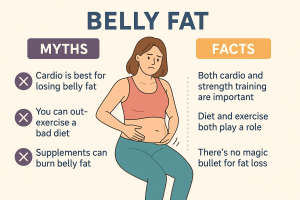Belly Fat Myths Women Still Believe (and the Truth Behind Them)
Every woman has heard conflicting advice about belly fat: Do more crunches! Eat less fat! Try this detox tea!
But here’s the truth — most of what you’ve been told about belly fat is outdated, oversimplified, or flat-out wrong.
Understanding what really causes belly fat and how to manage it effectively can help you not only reshape your waistline but also improve your long-term health.
Let’s bust the most common belly fat myths women still believe — and reveal the truth science says you should know.
Why Belly Fat Is a Bigger Issue Than You Think

The Science of Belly Fat
Belly fat isn’t just about appearance. It’s made up of two main types:
-
Subcutaneous fat – The soft, pinchable fat beneath your skin.
-
Visceral fat – The deeper fat that surrounds your organs and raises risks for heart disease, diabetes, and hormonal imbalance.
Why Women Are More Prone to Belly Fat
Due to hormonal fluctuations — particularly estrogen and cortisol — women’s bodies tend to store fat around the hips and waist, especially after 35.
Menopause also shifts fat storage from the lower body to the abdomen, making belly fat more stubborn with age.
Myth #1: Crunches Will Burn Belly Fat
The Truth: You Can’t Spot-Reduce Fat
No matter how many sit-ups or planks you do, you can’t target fat loss in one area.
Multiple studies, including one published in the Journal of Strength and Conditioning Research, found that abdominal exercises improve core strength — but have no effect on fat reduction in the stomach.
👉 Focus on full-body strength training and cardio to burn fat evenly.
Myth #2: Eating Fat Makes You Fat
The Truth: The Right Fats Help Burn Belly Fat
Healthy fats are essential for hormone production and fat metabolism.
Omega-3 fatty acids (from salmon, walnuts, and flaxseed) and monounsaturated fats (from olive oil and avocados) actually help reduce inflammation and regulate insulin, leading to better belly fat loss.
Avoid trans fats and fried foods — they’re the real culprits behind stubborn fat.
Myth #3: Skipping Meals Helps You Lose Belly Fat
The Truth: Metabolism Slows with Meal Skipping
When you skip meals, your body thinks it’s in survival mode. It raises cortisol levels and slows metabolism to preserve energy.
This leads to fat storage instead of fat burning, particularly around your waist.
Instead, eat balanced meals every 3–4 hours with protein, fiber, and healthy fats to keep your metabolism stable.
Myth #4: Cardio Is the Only Way to Burn Belly Fat
The Truth: Strength Training Burns Fat Even at Rest
While cardio helps burn calories, strength training builds muscle, which keeps your metabolism active 24/7.
According to research from Harvard Health, women who include resistance training at least 2–3 times per week have less visceral fat than those who only do cardio.
💡 Try a mix of:
-
3 strength workouts weekly
-
2 moderate-intensity cardio sessions
-
1 yoga or recovery day
Myth #5: Stress Doesn’t Affect Your Waistline
The Truth: Stress Hormones Drive Belly Fat
Chronic stress increases cortisol, your body’s “fight-or-flight” hormone.
When cortisol stays elevated, it signals your body to store fat around the abdomen — a protective response from your evolutionary biology.
To reduce cortisol naturally:
-
Get 7–9 hours of sleep
-
Practice deep breathing or meditation
-
Walk outdoors daily
Myth #6: All Calories Are Equal
The Truth: Nutrient Density and Hormonal Response Matter
A 200-calorie candy bar doesn’t affect your body the same way as 200 calories of salmon and veggies.
Refined carbs spike insulin — leading to fat storage — while whole foods stabilize blood sugar and boost metabolism.
Quality matters just as much as quantity.
Myth #7: Belly Fat Is Only About Appearance
The Truth: Belly Fat Is a Health Warning Sign
Visceral belly fat isn’t just stubborn — it’s dangerous.
It increases your risk of:
-
Type 2 diabetes
-
Heart disease
-
PCOS and hormonal imbalance
-
Chronic inflammation
Losing belly fat isn’t about getting a flat stomach — it’s about reclaiming your health and energy.
The Real Science of Losing Belly Fat

Balanced Nutrition
Focus on whole, nutrient-dense foods like lean proteins, vegetables, whole grains, and healthy fats.
Avoid sugar-laden snacks and ultra-processed foods.
Strength + Cardio Combo
Build muscle through resistance training while maintaining heart health through cardio.
Consistency is key — aim for 150+ minutes of movement per week.
Sleep, Stress, and Recovery
Your body burns fat most efficiently when you rest.
Prioritize sleep, reduce stress, and allow your muscles to recover between workouts.
FAQs on Belly Fat Myths
1. Why do women get belly fat after 40?
Hormonal changes (lower estrogen, higher cortisol) slow metabolism and shift fat storage to the abdomen.
2. Can I lose belly fat without exercise?
Yes, through diet — but combining both yields the best results.
3. How long does it take to lose belly fat naturally?
With consistency, most women see visible results in 8–12 weeks.
4. Do certain foods burn belly fat?
Foods high in protein, fiber, and omega-3s (like salmon and chia seeds) help promote fat loss.
5. Can belly fat return after losing it?
Yes, if stress, sleep, or diet habits aren’t maintained. Fat loss is reversible without consistency.
6. Are “belly fat detoxes” effective?
No. Detoxes cause temporary water loss, not real fat loss.
Conclusion: Replace Myths with Mindful Science
Belly fat myths persist because they promise fast fixes — but true fat loss is about balance, not restriction.
The truth? You can’t hack your hormones or out-exercise bad habits.
But by eating smart, lifting weights, sleeping well, and managing stress, you can reshape your body from the inside out.
👉 Science doesn’t lie — but myths do. Replace them with mindful habits, and your waistline (and health) will thank you.
💡 Learn more at Harvard Health: Understanding Belly Fat.


